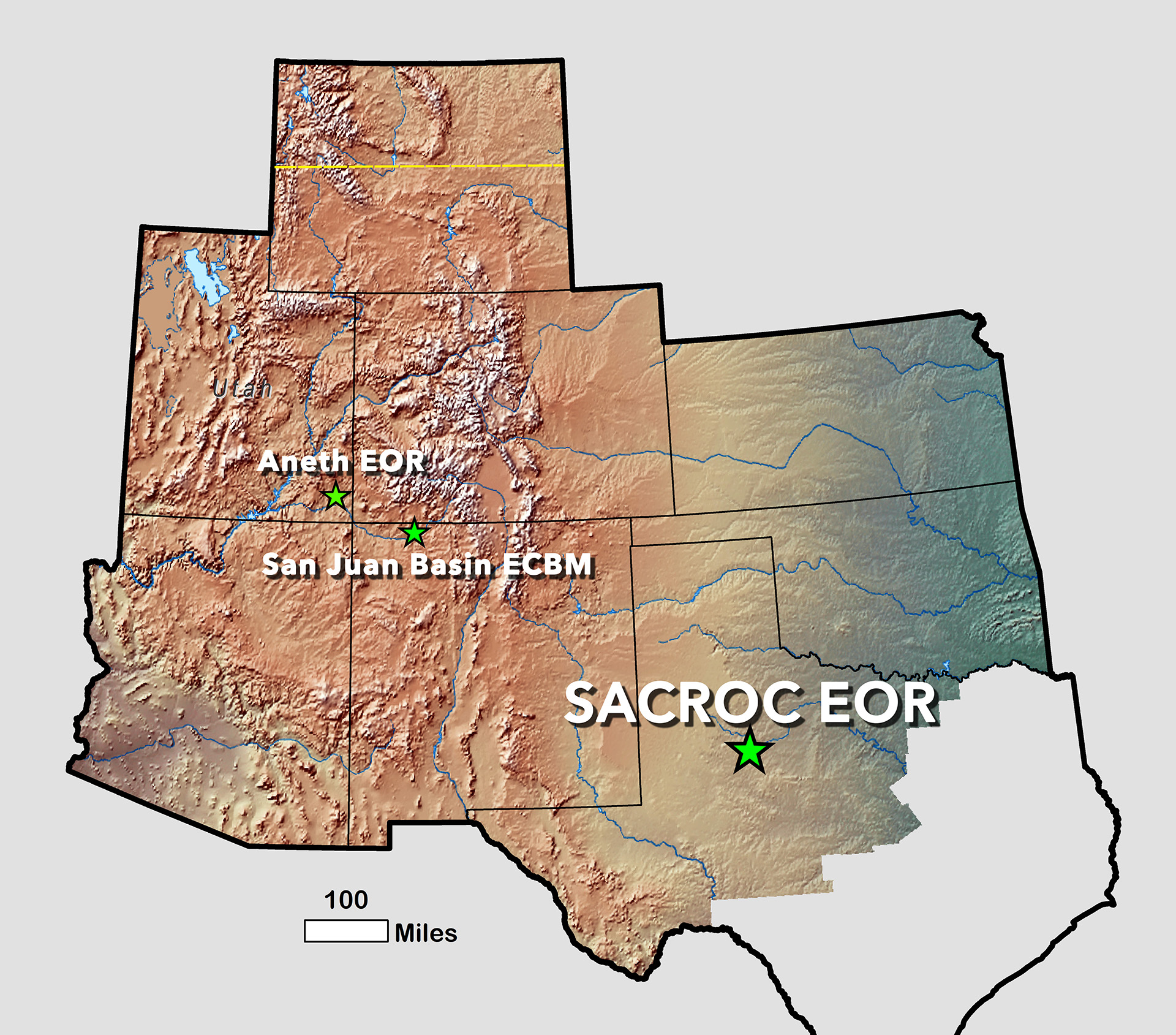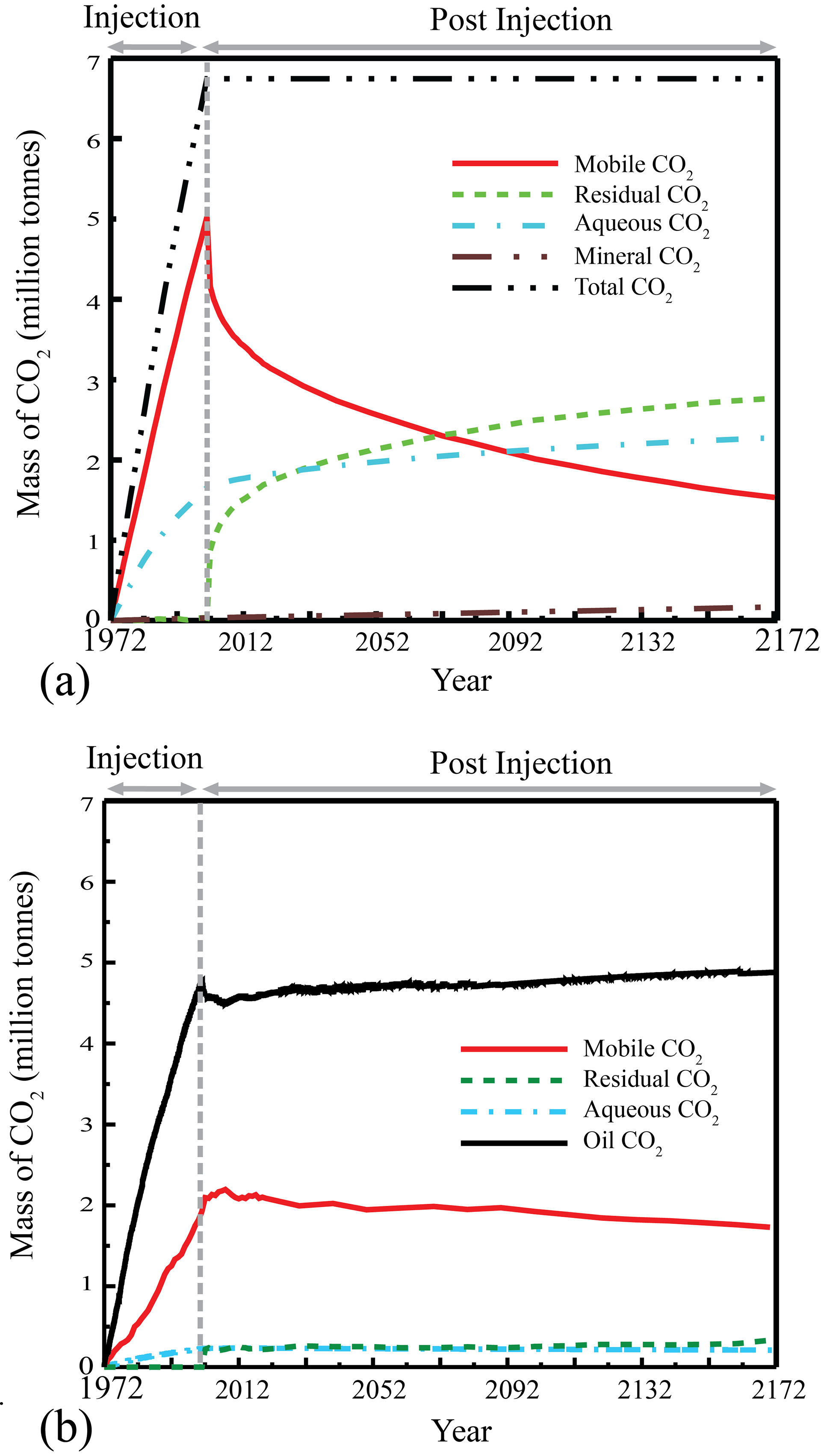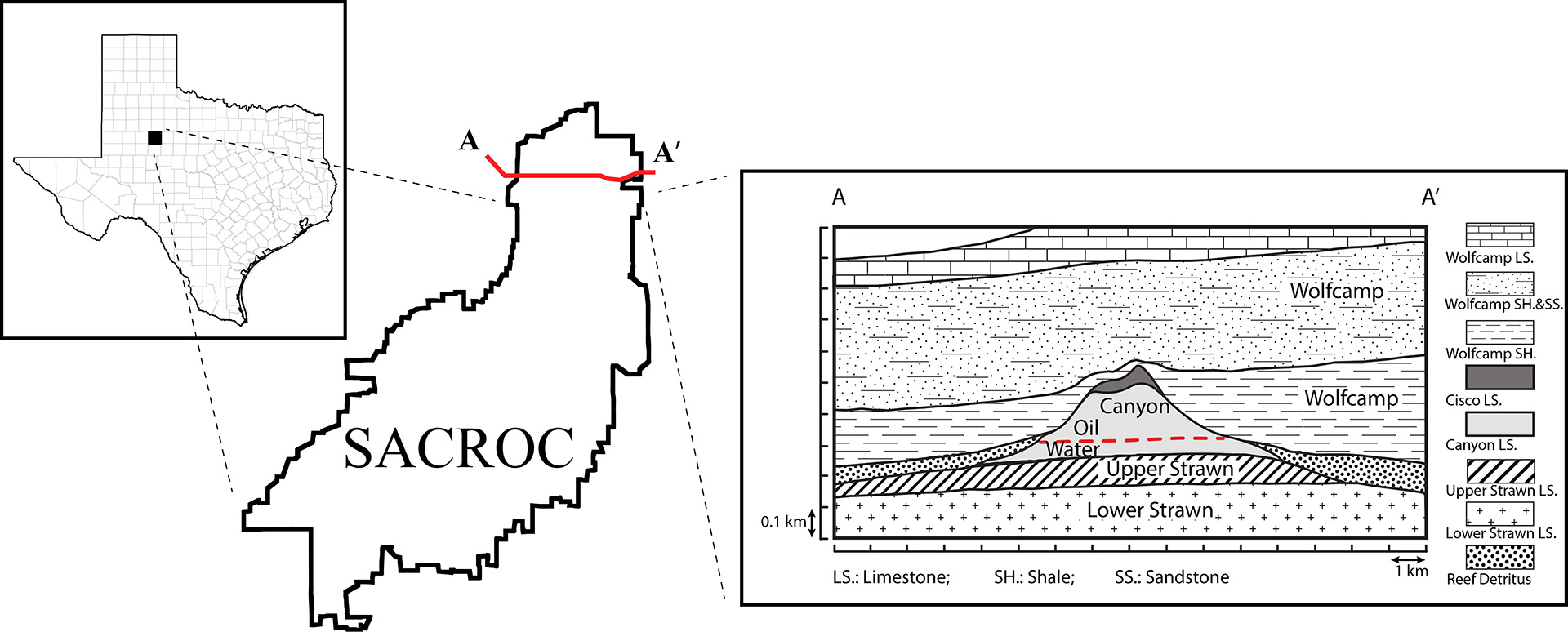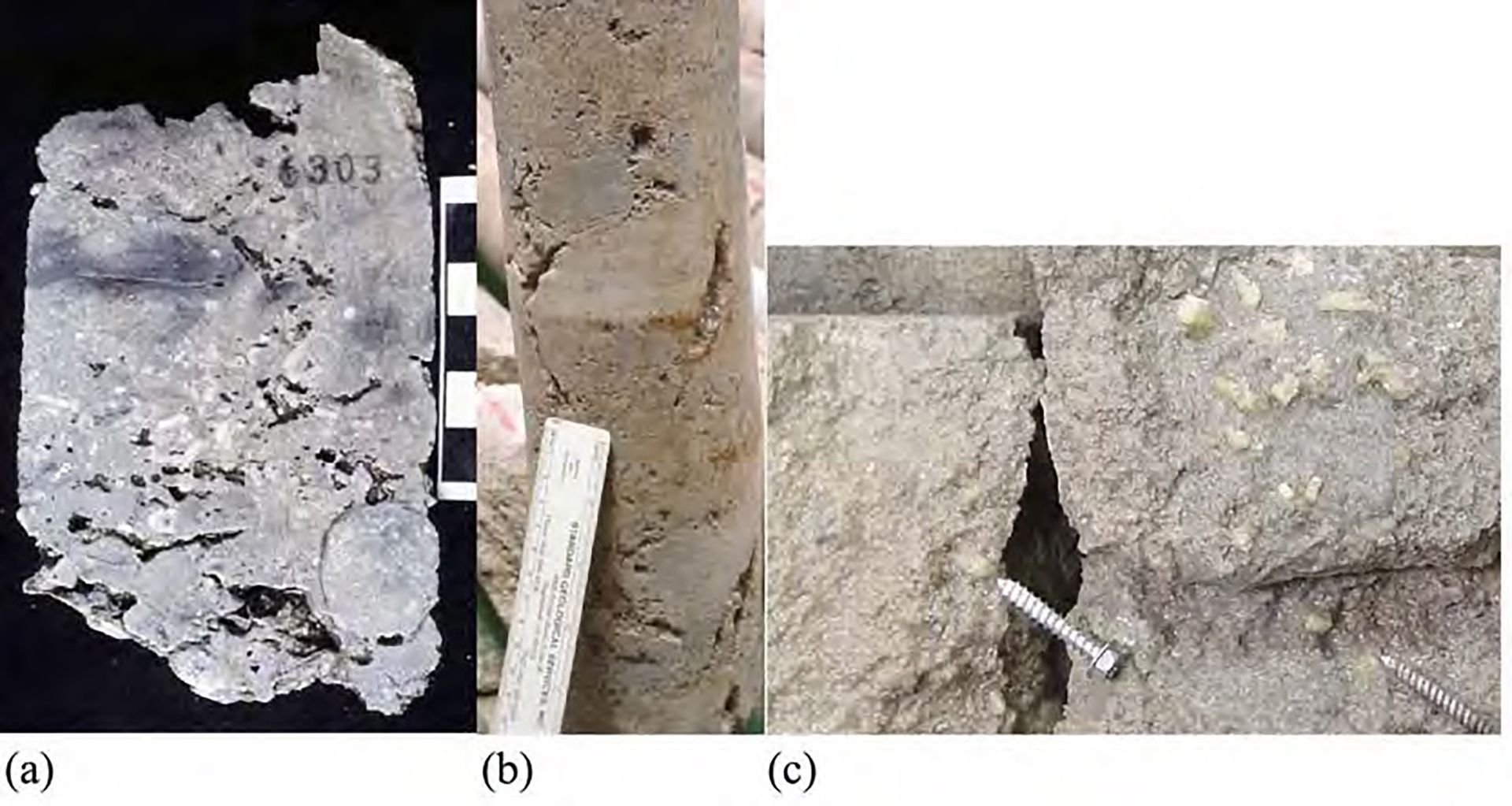Carbon Storage Atlas
- Why this Location
- Main Research Q&As Discovered
- Lessons Learned
- Field Site Story of Interest
- Geologic Details
- Links to EDX
- Sites
Lat/Long
The Scurry Area Canyon Reef Operator’s Committee (SACROC) Unit, within the southeastern segment of the “Horseshoe Atoll” within the Midland basin of west Texas.
32.734752, -100.947882
Why this Location
The Scurry Area Canyon Reef Operator’s Committee (SACROC) location was attractive for this project because it is the oldest continuously operated carbon dioxide (CO2) enhanced oil recovery (EOR) operation in the United States, having undergone CO2 injection since 1972. The SACROC Unit continues to be flooded by the current operator, Kinder Morgan CO2 Company. For the past several decades, petroleum engineers and geologists have extensively investigated this site for the purpose of better understanding CO2-EOR. The area attracted the attention of CO2 storage researchers because of the long and well-documented history of CO2 injection. The length of exposure presented a good area to study and confirm trapping mechanisms of CO2 in the presence of hydrocarbons, as well as a valuable area should stacked layer storage be contemplated..
Main Research Q&As Discovered
The main research questions of the Scurry Area Canyon Reef Operator’s Committee (SACROC) Unit pilot study include evaluation of efficacy of carbon dioxide storage via enhanced oil recovery (CO2-EOR); risk assessment; and optimization of monitoring, verification, and accounting (MVA) protocols. While trapping mechanisms had been extensively investigated for CO2 storage in deep saline aquifers, few studies had focused on evaluating CO2 trapping mechanisms for CO2-EOR, where the hydrocarbons are present in the subsurface. Moreover, as compared with storage in deep saline aquifers, a typical CO2-EOR site would have more complex infrastructure, as well as a lengthy and sometimes complicated operational history, which may jeopardize safety and security of injected CO2. Therefore, the Southwest Regional Partnership on Carbon Sequestration (SWP) team felt there was high value in critical questions associated with CO2-EOR through the SACROC Unit site study.
An approach combining detailed site characterization, numerical modeling and simulation, and various MVA techniques was used to address research questions. A geocellular model based on analysis of well logs and 3D seismic surveys was developed to represent the northern platform at the SACROC Unit, and then converted to a dynamic reservoir model to predict CO2 migration and quantify roles of each trapping mechanism. Additional data from core measurements was used to parameterize the 3D heterogenous reservoir model. Simulation results suggested that oil solubility trapping is the dominant trapping mechanism, followed by hydrostratigraphic trapping. Other trapping mechanisms, including the residual trapping, aqueous trapping, and mineral trapping, demonstrated minor roles for CO2 storage at the SACROC Unit in the 200-year simulation period. In addition, various MVA techniques were utilized to confirm the safety and security of CO2 storage at the SACROC Unit. Specifically, the time-lapse vertical seismic profiles (VSP) detected the changes due to migration of CO2 plume within geologic formations, which are consistent with the results of surface reflective seismic survey. Soil flux monitoring and groundwater studies showed that neither the surface nor the shallow drinking water over the SACROC Unit has been impacted by CO2 storage in deep subsurface reservoirs.
Lessons Learned
The Scurry Area Canyon Reef Operator’s Committee (SACROC) Unit pilot was an example of a medium-scale validation test in a sink that may have capacity for possible larger-scale storage operations in the future. These validation tests also demonstrate multiple value-added benefits for enhanced oil recovery (EOR) and storage. The SACROC Unit study during Phase II provided valuable experience for going forwards into the Southwest Regional Partnership on Carbon Sequestration’s (SWP) Phase III project, which is a large scale carbon dioxide (CO2)-EOR project located in the Farnsworth Unit in northern Texas. Efficacy of CO2 trapping mechanisms in CO2-EOR, site characterization, and monitoring, verification, and accounting (MVA) protocols, all of which learned from the SACROC Unit project, played critical roles in designing the SWP Phase III project. The approach of dividing research into working groups such as characterization, simulation, MVA, and risk-assessment was initiated in the SACROC Unit project. In addition, the SWP team strengthened its non-technical capabilities through clear communication with operators and effective outreach in the SACROC Unit project, which was also important in the SWP Phase III project.
Story of Interest
The Southwest Regional Partnership on Carbon Sequestration (SWP) evaluated the efficacy and security of carbon dioxide (CO2) geological storage via enhanced oil recovery (EOR) at the Scurry Area Canyon Reef Operator’s Committee (SACROC) Unit site. Roles of each CO2 trapping mechanisms were deterministically quantified over a 200-year period consisting of CO2 injection and post-injection site monitoring periods.
Almost two-thirds of the injected CO2 was dissolved in oil presented in the SACROC Unit model. Less than one-third of injected CO2 remained in the free supercritical phase and was hydrostratigraphically trapped. Aqueous trapping, residual trapping, and mineral trapping had insignificant roles during the 200-year period.
In addition, a brine-only model was developed and simulated to investigate potential CO2 storage if the SACROC Unit site was a deep saline aquifer. Excluding hydrocarbons from the storage scenario, hydrostratigraphic trapping became the dominant trapping mechanism, followed by aqueous trapping and residual trapping. Unlike the CO2-EOR storage scenario, the brine-only model predicted that about half of free mobile CO2 would be either dissolved in brine or residually trapped in pore spaces, both of which would hinder CO2 migration in the surface and thus increase CO2 storage safety. Therefore, a stacked storage that injects CO2 into an aquifer beneath a hydrocarbon reservoir would provide extra CO2 storage capacity and security.
Finally, the uncertainty associated with CO2 storage at the SACROC Unit site was quantified in the Monte Carlo approach. While uncertainty in model parameters affects CO2 flow patterns in the subsurface, the relative importance of each trapping mechanism does not vary significantly from the deterministic analysis.
Geologic Details
The Scurry Area Canyon Reef Operator’s Committee (SACROC) Unit is located in the southeastern segment of the “Horseshoe Atoll” within the Midland basin in western Texas. The Horseshoe Atoll is a reef mound composed of mixed types of in-place boundstones and bioclastic debris accumulated during the late Paleozoic era. Geologically, the carbonate reef complex at the SACROC Unit is composed of massive amounts of bedded bioclastic limestone and thin shale beds (millimeters to centimeters in thickness) representing the Strawn, Canyon, and Cisco Formations of the Pennsylvanian and the Wolfcamp Series of the Lower Permian.
The oil at the SACROC Unit is produced from the Canyon and Cisco Formations, which are in Pennsylvanian age. The carbonate reef complex developed in the early Strawn (Desmoinesian), while the basin was on the equator. During the formation of the Canyon (Missourian) and Cisco (Virgilian), carbonate sedimentation continued. Accumulation of carbonate sediments on the SACROC Unit ended during the Wolfcampian due to the drastic influx of fine-grained clastics. A majority of the Canyon and Cisco Formations are composed of limestone, but minor amounts of anhydrite, sand, chert, and shale are present locally. The Wolfcamp shale of the lower Permian provides a low-permeability seal above the Pennsylvanian Cisco and Canyon Formations.
Raines, M. A., 2003. Reef heterogeneity as seen by wireline and cross-well seismic in the Pennsylvanian SACROC Unit, Scurry County, Texas. The Permian Basin: Back to Basics West Texas Geological Society Fall Symposium, October 8- 10, 2003. Abstract in: Hunt, Tim J. and Lufholm, Peter H. (eds.) The Permian Basin: Back to Basics WTGS Publication # 03-112. West Texas Geological Society, Midland, Texas, p.325.
Links to EDX
SACROC CMG Model
This model was built for simulating carbon dioxide (CO2)-enhanced oil recovery (EOR) at the Scurry Area Canyon Reef Operator’s Committee (SACROC) northern platform. Wei Jia, Brian McPherson, SACROC CMG model, 2018-01-10, https://edx.netl.doe.gov/dataset/sacroc-cmg-model, DOI: 10.18141/1465116







